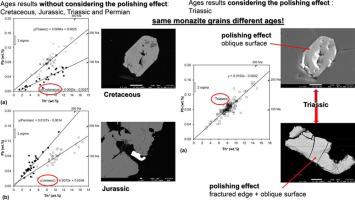Journal of Asian Earth Sciences ( IF 2.7 ) Pub Date : 2021-06-02 , DOI: 10.1016/j.jseaes.2021.104844 Fiorenza Deon

|
A first attempt of Electron microprobe (EMP) based Th-U-total Pb in situ dating of monazites in tailings from a placer deposit (quartz bearing sands) from Bangka Island, Indonesia, revealed for the first time from a single locality in Indonesia an age cluster around 231 Ma as well as two single grains with ages of 1133 Ma and 1916 Ma. The monazite ages from this study agree with detrital zircon ages and whole rock isochron ages from magmatic intrusions, which were reported from various localities all over the Malaysian peninsula, Myanmar and Thailand but not yet from Bangka Island. Perhaps intrusions in the closer vicinity, which could be the source of the monazite under study, have not been discovered so far or the sedimentary catchment area of the placer deposit is much larger than assumed so far. The existence of the monazite ages investigated in this study may also raise the question of the paleogeographic position of Bangka Island and the relative timing of sedimentation and Miocene rifting. However, the present work is an excellent example for the resistance of monazite and its Th-U-Pb system to sedimentary processes and hence is a useful tool for provenance studies and source of Rare Earth Element (REEs) recovery. An important outcome of this study is that sedimentary monazite relics often provide a wide range of unrealistic ages. Such dates may be wrongly explained in terms of recrystallization along with metasomatic process, instead these ages are only a methodic artefact because monazite relics are either not thick enough for dating or show poor surfaces with numerous cracks.
中文翻译:

来自印度尼西亚邦加岛锡砂矿床的电子微探针独居石年龄
首次尝试基于电子微探针 (EMP) 对来自印度尼西亚邦加岛砂矿床(含石英砂)的尾矿中的独居石进行 Th-U-总铅原位定年,首次在印度尼西亚的一个地方发现231 Ma 附近的年龄簇以及年龄分别为 1133 Ma 和 1916 Ma 的两个单粒。本研究的独居石年龄与岩浆侵入的碎屑锆石年龄和全岩等时线年龄一致,这些年龄在马来西亚半岛、缅甸和泰国各地均有报道,但尚未从邦加岛报道。也许较近的侵入体可能是所研究的独居石的来源,但到目前为止尚未发现,或者砂矿的沉积集水区比目前假设的要大得多。本研究调查的独居石时代的存在也可能引发邦加岛古地理位置以及沉积和中新世裂谷的相对时间问题。然而,目前的工作是独居石及其 Th-U-Pb 系统抵抗沉积过程的一个很好的例子,因此是物源研究和稀土元素 (REE) 回收来源的有用工具。这项研究的一个重要结果是,沉积独居石遗迹往往提供广泛的不切实际的年龄。这些年代可能被错误地解释为重结晶和交代过程,相反,这些年代只是一种有条不紊的人工制品,因为独居石遗迹要么不够厚,无法测年,要么表面质量差,有许多裂缝。











































 京公网安备 11010802027423号
京公网安备 11010802027423号